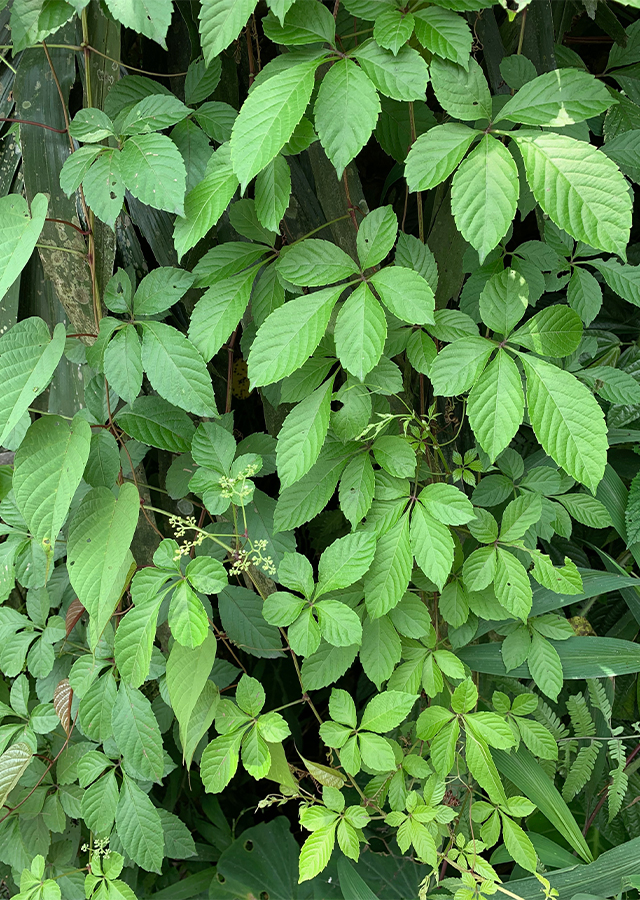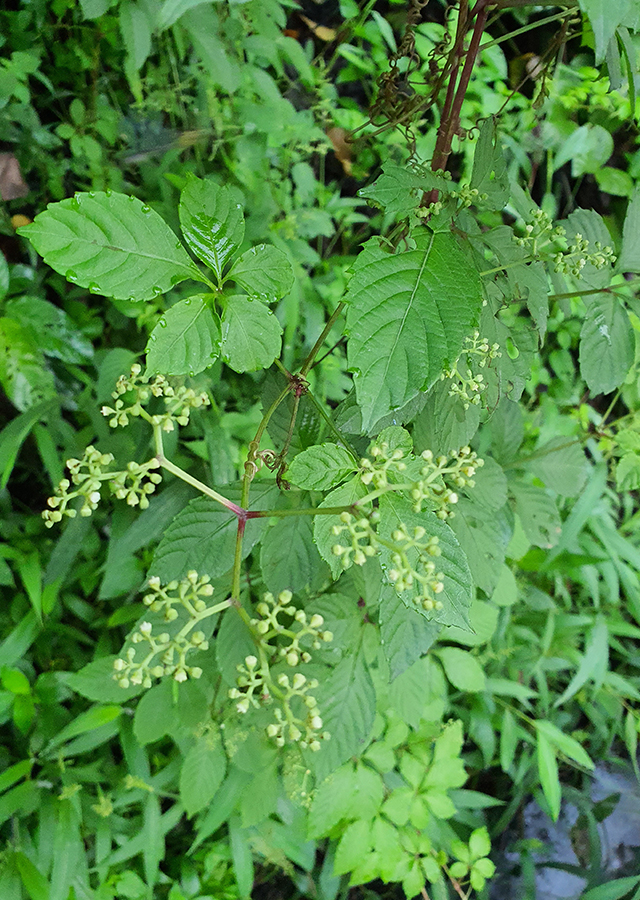Sweet Tea Vine
Gynostemma pentaphyllum (Thunb.) Makino
Cucurbitaceae
Location in our garden
Principal



Synonym
Alsomitra cissoides M.Roem.
Alsomitra laxa (Wall.) M.Roem.
Gynostemma blumei Hassk.
Habitus
Climbers. An annual to short lived- perennial, dioecious, herbaceous climbing vine
Part Used
The Whole Plant
Growing Requirements
Need Shade
Habitat
Forest
Shrublands
Overview
This plants is native to Himalayan region, East Asia, Indochina and South East Asia. The plant has vary form of the morphology. In China, this plant is known as Jiaogulan that has been revered for millennia as tonic herb. Known as “poor man’s ginseng”, it is as a powerful an adaptogen as ginseng with many other benefits to health. The plant also produces edible young shoots, a tea and a cosmetic.
Vernacular Names
Xiancao (Chinese), Amachazuru (Japanese), Dungkulcha (Korean), Giao-co-lam tea (Vietnamese).
Agroecology
It occurs in forest, thickets or road sides on mountain slopes at elevations of 300-3,200 m in China. A plant of low elevations in the warm temperate to tropical zones. Requires a rich well-drained but moisture-retentive soil in a warm sheltered position in partial shade.
Morphology
- Stems and branches - slender, angular-sulcate, glabrous or sparsely pubescent.
- Leaves - pedately 3-9-foliolate, usually 5-7-foliolate, membranous or papery, pubescent or glabrous, leaflets ovate-oblong or lanceolate.
- Flowers - male flowers in panicle, peduncle filiform, many branched; pedicels filiform, bracteole subulate, calyx tube very short; segments triangular; corolla pale green or white. Female flowers: panicle shorter than male flowers; calyx and corolla as in male flowers, ovary globose.
- Fruits - indehiscent, black when mature, globose, 5-6 mm in diameter, 2-seeded, glabrous or densely hispid and pubescent.
- Seeds - brown, ovate-cordate, 4 mm in diameter, compressed, both surfaces papillose, base cordate, apex obtuse.
Cultivation
- Propagated through seeds and stem cuttings.
Chemical Constituents
Flavonoids, ombuin, ergostanol, sitosterols, stigmasterol, saponins, cholestanol, acetylenic sterol, rutin, allantoin, vitexin, amino acid.
Traditional Medicinal Uses
Medicinal Uses
- Considered antimicrobial, anticancer, antiaging, antifatigue, antiulcer, hypolipidemic, immune-modulatory activities, anti-inflammatory, antitumor, antioxidant, hepatoprotective and neuroprotective activities, antiexercise fatigue properties, and as a therapeutic agent for the treatment hyperlipidemia disorders.
- The whole plant is used to improves the circulation, stimulates liver function, strengthens the immune and nervous systems, and reduces blood sugar and cholesterol levels. It also has sedative effects, relieving spasms and lowering the blood pressure.
Traditional Uses
- The whole plant is tonic, used internally in the treatment of nervous tension and exhaustion, peptic ulcer, asthma, bronchitis, diabetes, cardiovascular disease and cancer. It was rated among the ten most important tonic herbs at a conference on traditional medicines in Beijing in 1991.
Part Used
Reference Sources
- Drugs Herbal. (No date). Jiaogulan. https://www.drugs.com/npp/jiaogulan.html#:~:text=%29%20Makino.%20Common%20Name%28s%29%3A%20Amachazuru%20%28Japan%29%2C%20Dungkulcha%20%28Korea%29%2C,vine%2C%20Twisting-vine%20orchid%2C%20Xiancao%20%28China%29%20Clinical%20Overview%20Use. 16-01-2021.
- Fern, Ken. (2014). Useful Tropical Plants. Gynostemma pentaphyllum (Thunb.) Makino. http://tropical.theferns.info/viewtropical.php?id=Gynostemma+pentaphyllum. 10-10-2020.
- Flora of China. (No date). Gynostemma pentaphyllum (Thunberg) Makino. http://www.efloras.org/florataxon.aspx?flora_id=2&taxon_id=200022642. 10-10-2020.
- Indigo herbs. (No date). Gynostemma Benefits. https://www.indigo-herbs.co.uk/natural-health-guide/benefits/gynostemma. 10-10-2020.
- Xiaolong Ji, Yingbin Shen, and Xudan Guo. (2018). Isolation, Structures, and Bioactivities of the Polysaccharides from Gynostemma pentaphyllum (Thunb.) Makino: A Review. BioMed Research International. Volume 2018 |Article ID 6285134 | https://doi.org/10.1155/2018/6285134. 10-10-2020.
- W.J.J.O. de Wilde & Brigitta E.E. Duyfjes. (2010) Cucurbitaceae. Flora Malesiana Series I (19): 1-333.
